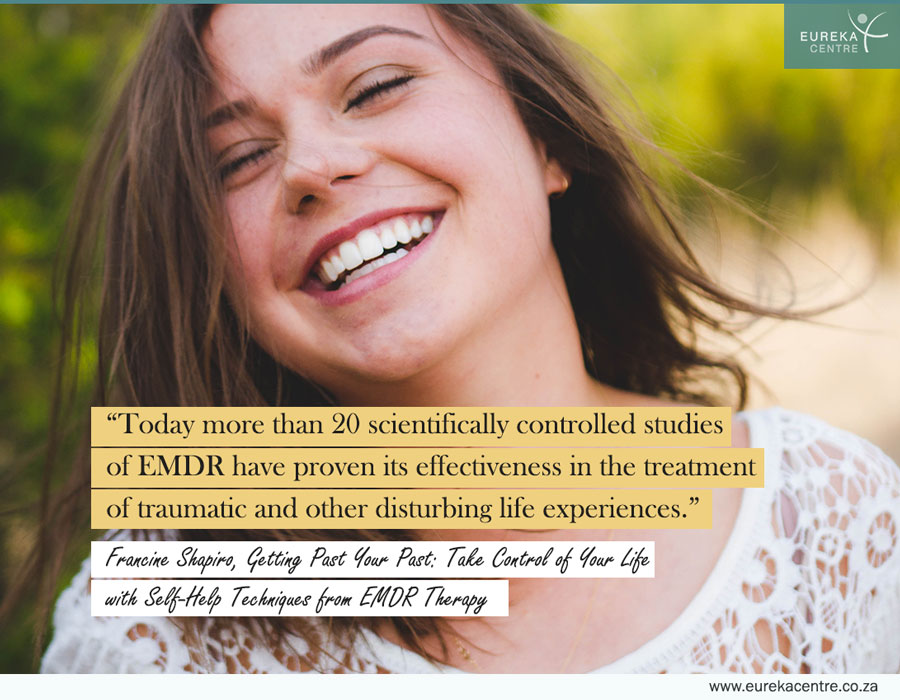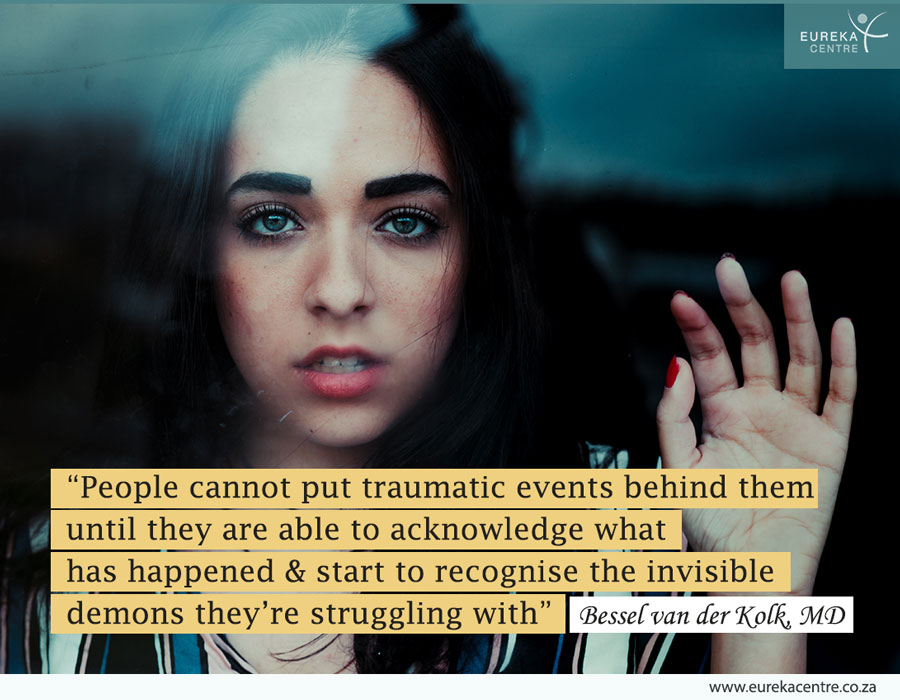
- (012) 667 6188
- 083 301 8000
- jeanette@eurekacentre.co.za
Free Yourself From Trauma

Jeanette Dreyer
Jeanette Dreyer is passionate about helping her clients to identify the root their personal negative subconscious programming & guiding them to change their lives for the better.

Licensed EMDR Clinician
(EMDR Institute™)
Jeanette Dreyer is an experienced and licensed EMDR Clinician (EMDR Institute™)
EMDR
“Eureka Centre provides Eye Movement Desensitisation and Reprocessing Treatment which can be an extremely effective treatment”
EMDR is an integrative psychotherapy approach that has been extensively researched and proven effective for the treatment of trauma. It is capable of a rapid desensitization of traumatic memories and relief from the symptoms of PTSD, e.g. flashbacks and nightmares.
Eureka Centre provides Eye Movement Desensitisation & Reprocessing Treatment which can be an extremely effective treatment for:
Post Traumatic Stress due to:
- Armed Robbery
- Accident
- Attempted Murder
- Hi-jack
- Rape
- Smash-and-Grab
Phobias:
- Agoraphobia
- Claustrophobia
- Social Phobia
Fear of:
- Driving
- Flying
- Heights
- Public Speaking
After EMDR treatment, a client will still remember the incident, but they will see the memory in a new & less distressing way.
If you are struggling to move on after an armed robbery or physical assault, EMDR is an effective therapy to help you process the trauma & move past it.
What is EMDR?
Please be advised:
We have many satisfied clients and we achieve excellent results. However, no therapist can ever guarantee results. Results may vary & every situation is different.

Find your Freedom
Are there aspects in your life that you’d like to change in order to be happier, more peaceful, more confident, more successful, less stressed?
083 301 8000
Eureka Centre
Established in 1996 and based in Doringkloof, Centurion, Eureka Centre offers EMDR (Eye Movement Desensitisation & Reprocessing Treatment) in a calm & peaceful environment.
For the past twenty years and more, we’ve helped many clients to free themselves from the self-destructive habits that were holding them back.
Would you like to live a happier, more peaceful, more confident, more successful, less stressed life?
Book an appointment today for your own personal Eureka Experience.
Are you suffering with PTSD?
PTSD or Post Traumatic Stress Disorder can occur following a life-threatening event such as an attempted murder or armed robbery or a physical assault.
Most survivors of trauma will have symptoms such as nightmares and flashbacks that fade over time, but others develop PTSD as these symptoms persist or worsen.

Symptoms of trauma can begin immediately after a traumatic event, but PTSD is only diagnosed when some of the following symptoms have persisted for more than 30 days:
- Experiencing flashbacks
- Repeatedly having a sense of reliving the experience
- Nightmares & interrupted sleep
- Intense physical / emotional distress when reminded of the event
- Avoiding thoughts, conversations, activities or places that remind you of the experience
- A sense of tension, anxiety, irritability, hyperactivity
- Hypervigilance
- Easily startled
- Fear & loss of the sense of safety
- Outbursts of aggression or rage
- Problems in concentrating, reading, writing, speaking, short attention span
- Sense of being stuck
- Problems with making decisions
- Inability to recall parts of or all of a traumatic event
- Numbing & diminished interest in significant events
- Dulled feelings. Restricted range of emotions
- Detached from other people
- Problems with relationships or attachment
- Lack of sexual interest
- Absence of fantasy / no sense of future
- Feelings of guilt / shame
Can Post Traumatic Stress Disorder be Treated?
Yes! Eureka Centre provides EMDR (Eye Movement Desensitisation & Reprocessing) Treatment.
It is a new & exciting method assisting people with a variety of psychological problems. More than 20 scientifically controlled studies of EMDR have proven its effectiveness in the treatment of traumatic & other disturbing life experiences. It is capable of a rapid desensitization of traumatic memories and a removal of symptoms, e.g. flashbacks and nightmares.

Getting help for PTSD
At Eureka Centre we have a very experienced and gifted Clinical hypnotherapist & EMDR specialist, Jeanette Dreyer, who achieves excellent results.
If you are struggling to move on after an armed robbery or physical assault, EMDR is an effective therapy to help you process the trauma & move past it.
What is EMDR?
EMDR is an integrative psychotherapy approach that has been extensively researched and proven effective for the treatment of trauma.
When person has a traumatic experience, it may sometimes overwhelm usual ways of coping and the memory of the event is dysfunctionally stored in an isolated memory network. This leaves a person with a memory that is “frozen in time” with the original picture, sounds, thoughts, feelings and body sensations in tact and all-too accessible.
This reliving of a memory can have a lasting negative effect on a person
The right-to-left eye movements or tones of EMDR are similar to what occurs naturally during REM sleep and has been shown to help the brain with processing of information.
After EMDR treatment, a client will still remember the incident, but they will see the memory in a new and less distressing way.
What is the difference between Hypnotherapy & EMDR?
During hypnotherapy the therapist induces a hypnotic trance and helps the client to gain certain insights whereas in EMDR the client goes into a trance spontaneously and gains the insight himself.
The eye movements have a desensitising effect which can bring quick and lasting relief from various symptoms resulting from trauma.
EMDR is an effective and rapid method for healing Post Traumatic Stress Disorder (PTSD) e.g. after a rape, a hi-jack, an armed robbery, etc.
How does EMDR Work?
When a traumatic experience occurs it may overwhelm usual ways of coping and the memory of the event is dysfunctionally stored in an isolated memory network.
When this memory network is activated, the individual may re-experience aspects of the original event, often resulting in inappropriate overreactions. This is why people who have been raped, hi-jacked or been in an armed robbery, have recurring flashbacks, thoughts or dreams.

The 8 Phases of EMDR Therapy
EMDR uses a structured eight-phase approach and works directly with memory networks and enhances information processing by forging associations between the distressing memory and more adaptive information contained in other semantic memory networks.
The distressing memory is transformed when new connections are forged with more positive and realistic information.
This results in a transformation of the emotional, sensory and cognitive components of the memory so that, when it is accessed, the individual is not longer distressed.
Instead he/she recalls the incident with a new perspective, new insight, resolution of the cognitive distortions, elimination of the emotional distress and relief of related physiological arousal.

EMDR uses a structured eight-phase approach and addresses the past, present and future aspects of the dysfunctionally stored memory.
During the processing phases of EMDR, the client attends to the disturbing memory in multiple brief sets of about 15-30 seconds, while simultaneously focusing on the therapist-directed lateral eye movement, alternative hand-tapping or bi-lateral auditory tones.
Following each set of such dual attention, the client is asked what associative information was elicited during the procedure. This new material usually becomes the focus of the next set. This process of alternating dual attention and personal association is repeated many times during the session.

EMDR Therapy Process
Phase 1 – Client History & Treatment Planning:
In the first sessions, the clients history and an overall treatment plan are discussed.
During this process the therapist identifies and clarifies potential targets for EMDR. Target refers to a disturbing issue, event, feeling or memory for use as an initial focus for EMDT.
Maladaptive beliefs are also identified.
Phase 2 – Preparation:
Before beginning EMDR for the first time, it is recommended that the client identify a safe place, an image or memory that elicits comfortable feelings and a positive sense of self.
This safe place can be used later to bring closure to an incomplete session or to help a client tolerate a particularly upsetting session.
Phase 3 – Assessment:
In developing a target for EMDR, prior to beginning the eye movements, a snapshot image is identified that represents the target and the disturbance associated with it.
Using that image is a way to help the client focus on the target, a negative cognition (NC) is identified – a negative statement about the self that feels especially true when the client focuses on the target image, e.g. “I am not good enough”.
A positive cognition (PC) is also identified – a positive self-statement that is preferable to the negative cognition, e.g. “I am good enough”.
Phase 4 – Desensitization:
The therapist asks the client to focus simultaneously on the image, the negative cognition, and the disturbing emotion or body sensation.
Then the therapist usually asks the client to follow a moving object with his or her eyes; the object moves alternately from side to side so that the client’s eyes also move back and forth.
After a set of eye movements, the client is asked to report briefly on what has come up; this may be a thought, a feeling, a physical sensation, an image, a memory, or a change in any of the above.
In the initial instructions to the client, the therapist asks him/her to focus on this thought, and begins a new set of eye movements. Under certain conditions, however, the therapist directs the client to focus on the original target memory or on some other image, thought, feeling, fantasy, physical sensation or memory.
From time to time the therapist may query the client about his/her current level of distress. The desensitisation phase ends when the SUDS (“subjective units of disturbance scale”) has reached 0 or 1.
Phase 5 – The “Installation Phase”:
The therapist asks the client about the positive cognition, if it is still valid. After Phase 4, the view of the client on the event/ the initial snapshot image may have changed dramatically.
Another PC may be needed. Then the client is asked to “hold together” the snapshot and the (new) PC.
Also the therapist asks, “How valid does the PC feel, on a scale from 1 to 7?” New sets of eye movement are issued.
Phase 6 – The “Body Scan”:
The therapist asks if anywhere in the client’s body any pain, stress or discomfort is felt. If so, the client is asked to concentrate on the sore knee or whatever may arise and new sets are issued.
Phase 7 – Debriefing:
The therapist gives appropriate info and support.
Phase 8 – Re-evaluation:
At the beginning of the next session, the client reviews the past week, discussing any new sensations or experiences. The level of disturbance arising from the experiences targeted in the previous session is assessed.
An objective of this phase is to ensure the processing of all relevant historical events.

Are you suffering with PTSD?
At Eureka Centre we have a very experienced and gifted Clinical hypnotherapist and EMDR specialist, Jeanette Dreyer, who achieves excellent results, and we have many satisfied clients.
If you are struggling to move on after an armed robbery or physical assault, EMDR is an effective therapy to help you process the trauma and move past it.
Please be advised:
We have many satisfied clients and we achieve excellent results. However, no therapist can ever guarantee results. Results may vary & every situation is different.
Inside this Pack:
- Information about Eureka Centre
- Our list of Services
- Information about the structure of therapy sessions
- Information about how to make an appointment
- Patient details form
Download our Info Pack
- We care about your privacy & we won't share your contact details with anyone.
Testimonial Disclaimer
Testimonials found on this site are examples of what we have done for other clients, and what some of our clients have said about us.
However, no practice, including ours, can ever guarantee results. Results may vary and every situation is different.
No compensation was provided for these testimonials.
Testimonials
We at Eureka Centre have many satisfied clients. Below are some of their inspiring stories:
"EMDR for Trauma"
My husband, my daughter and I were very traumatised after a recent armed robbery. We went for two EMDR sessions each at Eureka Centre. Our lives are back to normal. We can sleep peacefully at night and the anxiety is gone!
– Eureka Centre Client
"EMDR for a traumatic event"
My 16 year old daughter experienced a traumatic event which happened 2 years earlier at school and after keeping it to herself for so long began to have serious panic attacks at school.
The result was she left her school and withdrew from normal life totally, feeling depressed and suicidal at times. Thank God we then discovered The Eureka Centre.
After quite intense therapy with Jeanette using EMDR and hypnotherapy, I can report that she has returned back to normal schooling and is totally positive about life again – it is like a miracle! I don’t know how we would have overcome this long dark episode in our lives had it not been for Jeanette at The Eureka Centre.
We can’t thank you enough!
– Eureka Centre Client
Ook in Afrikaans beskikbaar
Are there aspects in your life that you’d like to change in order to be happier, more peaceful, more confident, more successful, less stressed?
– BEL –
083 301 8000
Eureka Centre
Established in 1996 and based in Doringkloof, Centurion, Eureka Centre offers hypnotherapy in a tranquil environment.
For the past twenty years and more, we’ve helped many clients to free themselves from the self-destructive habits that were holding them back.
Would you like to live a happier, more peaceful, more confident, more successful, less stressed life?

































